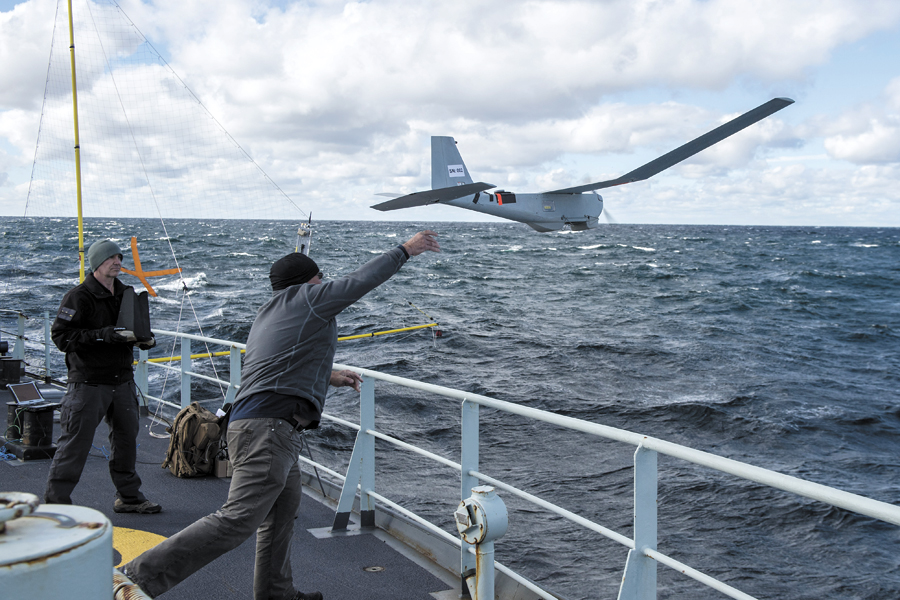Navy experiments with UAVs
By Lookout on Nov 22, 2016 with Comments 0

HMCS Summerside conducts Unmanned Aircraft System trials at sea, on Oct. 25. Photo by Master Seaman Ronnie Kinnie, Formation Imaging Services Halifax
DND ~
Historically, the Royal Canadian Navy (RCN) has been actively pursuing, on a very modest and experimental basis, a number of remote technology applications in each of the three maritime domains: air, surface, and sub-surface.
In terms of the undersea domain, the navy has operated everything from side scan sonars to remotely operated vehicles, and continues to actively participate in the development of these technologies.
The RCN was also active in the 1990s in developing remotely controlled surface targets and those investments are now reaping real benefits for Canadian industry.
In recent years, the RCN had great success operating the Scan Eagle from deployed frigates by leveraging a contractual mechanism that was put in place by the Canadian Armed Forces (CAF) to support our forces in Afghanistan.
Between 2012 and 2014, the combined organic intelligence, surveillance and reconnaissance capability resident in Halifax-class frigates along with the embarked Unmanned Aerial Systems (UAS) allowed the RCN to play a prominent role in expeditionary operations. Through cueing, detection, surveillance, and reporting from the shipborne Scan Eagle UAS, over nine metric tons of illegal drugs were intercepted by HMC Ships Charlottetown, Toronto, and Regina.
It proved to be an incredibly versatile and important extension of the ship’s sensors and embarked aircraft. It also allowed the RCN to learn valuable lessons on how to employ this capability, how to integrate into the maritime and littoral battle space, and how to operate in conjunction with an embarked maritime helicopter. It is a great force multiplier for a single ship or for a Naval Task Group.
Disruptive Technology
As technologies mature and evolve, the RCN is anticipating the gradual introduction of remotely piloted vehicles in all three maritime dimensions. Such vehicles, known as unmanned vehicles, will be well-suited for a range of tasks that will greatly extend the Commander’s situational awareness and potentially contribute to the expansion of assigned areas of responsibility.
It is envisaged that unmanned systems will also comprise an essential component of a joint force’s constellation of intelligence, reconnaissance, surveillance, and potentially Naval Fire Support assets, performing tasks in very high risk environments, delivering precision weapons, and conducting post-attack battle damage assessment.
“Notwithstanding being a disruptive technology, Unmanned Systems have the potential to positively impact future maritime operations. They can increase both the survivability and lethality of our own forces by increasing detection, communications, and engagement distances” says Commander Simon Nadeau, the Director of Naval Requirements Section Head.
Under the leadership of the RCN, the Director of Naval Requirements is embarking into several project initiatives. They will see the delivery of a complementary warfighting capability to ships at sea by having a level of autonomy between maritime unmanned systems, persistence, and expendability in order to enhance ships survivability along with generating a strategically relevant tactical advantage for commanders at sea across the full spectrum of operations.
UAV Capability Demonstration
On the international scene, the RCN observed Exercise Unmanned Warrior 2016 that was conducted on the Isle of Benbecuba, Scotland, under the leadership of the Royal Navy. Exercise Unmanned Warrior was a large-scale demonstration of maritime autonomous systems, in a tactically representative environment, including unmanned air, surface, sub-surface vehicles and sensors. In line with the UK Strategic Defence and Security Review direction on innovation and Defence exports, the UK Royal Navy invited industry, academia and certain defence partners, including the US Navy, to safely experiment and demonstrate the potential offered by maritime autonomous systems within the Joint Warrior operational environment in order to explore the feasibility and maturity of autonomous systems in delivering maritime capability.
Joint Warrior is a UK tri-Service multinational exercise that involves numerous warships, aircraft, marines and troops in which UK, NATO and allied units can go through training together in tactics and skills for use in a combined joint task force.
More recently, on Oct. 25, in partnership with MDA System Ltd. and AeroVironment Inc, Director of Naval Requirements conducted a capability demonstration aboard HMCS Summerside where the AeroVironment RQ-20 Puma was evaluated.
Despite less than favorable weather conditions, the demo was a great success and the team was able to demonstrate the launch and recovery from a Kingston-class, the quick re-deployment of the UAV, Electro-Optical and Infrared (EO/IR) imagery beyond the visual horizon, all while maintaining covertness of the aircraft.
“By conducting this demonstration in a real maritime environment, it better informed the RCN of the benefits and potential application of this relatively new technology for future missions”, said Commander Nadeau.
Current Unmanned Initiatives
The Remote Minehunting and Disposal System will be a modular, stand-off Naval Mine Countermeasures capability, designed to provide the full spectrum of Naval Mine Hunting operations and contribute to underwater domain awareness. A preliminary estimate is between $20 million to $40 million.
The RCN Intelligence, Surveillance, Target Acquisition and Reconnaissance (ISTAR) UAS will be a shipborne, complementary, persistent, near-real time, over the horizon, ISTAR capability that will enhance self-defence for deployed HMC Ships along with generating a strategically relevant tactical advantage for commanders at sea across the full spectrum of operations. A preliminary estimate is between $100 million to $249 million.
Filed Under: Top Stories
About the Author:





